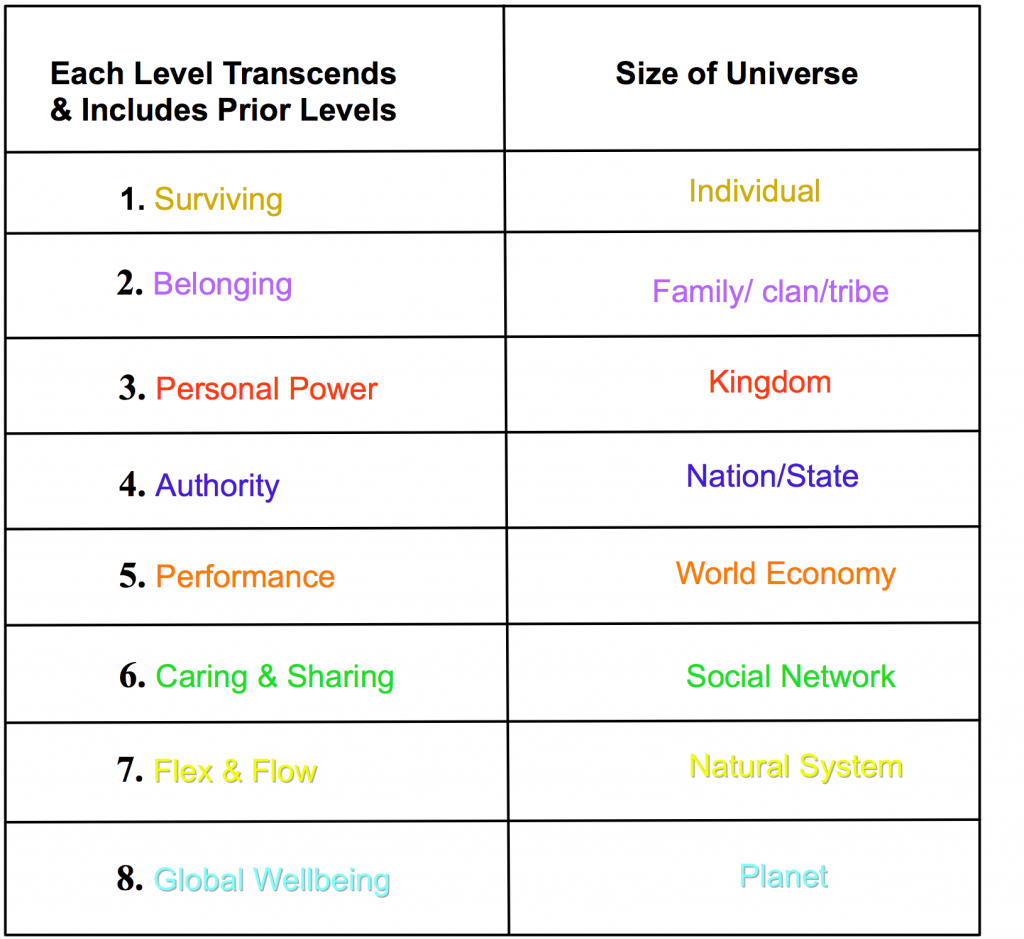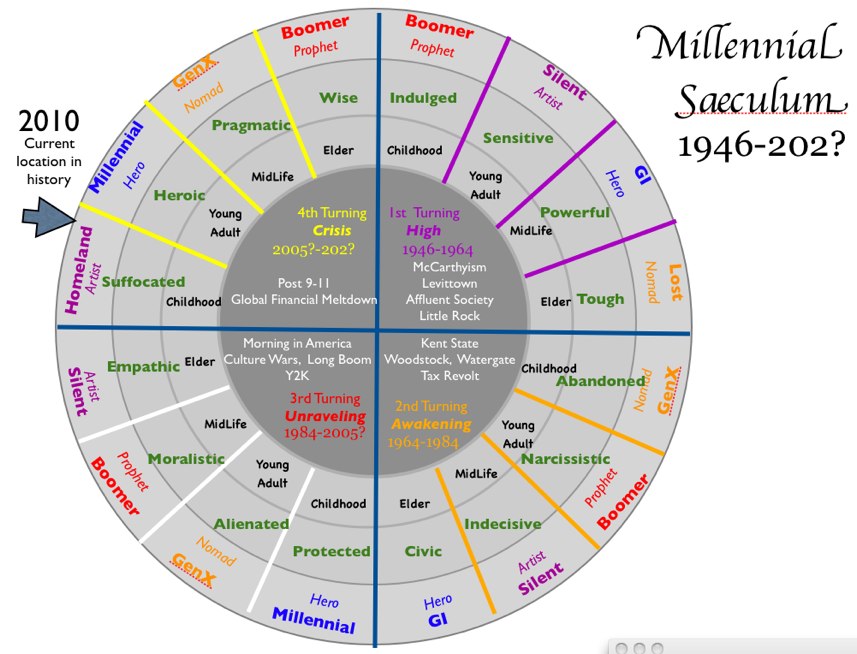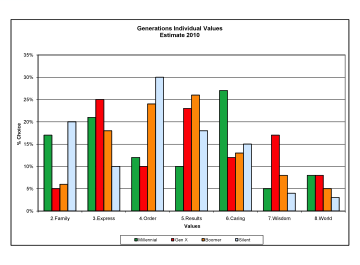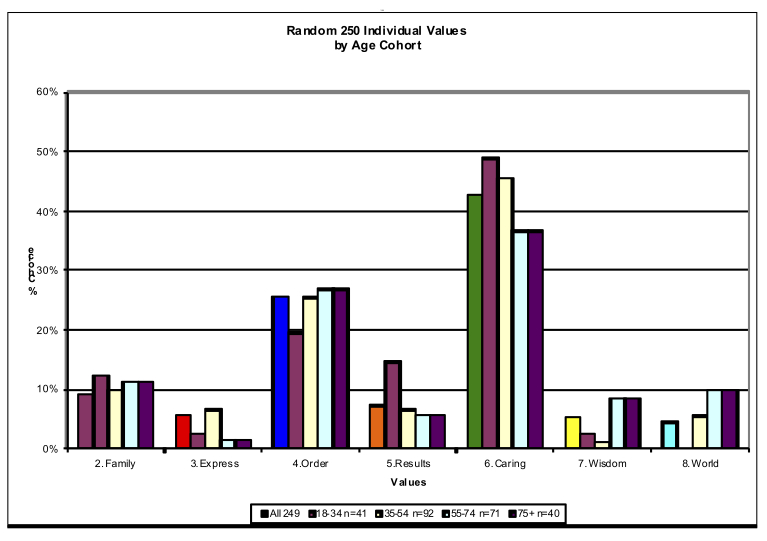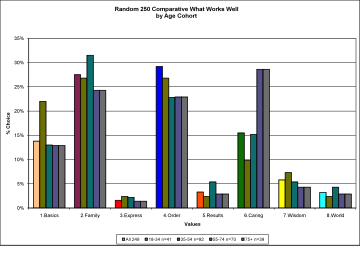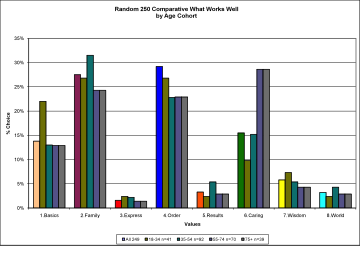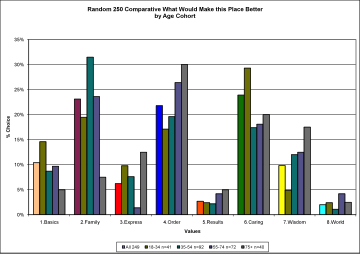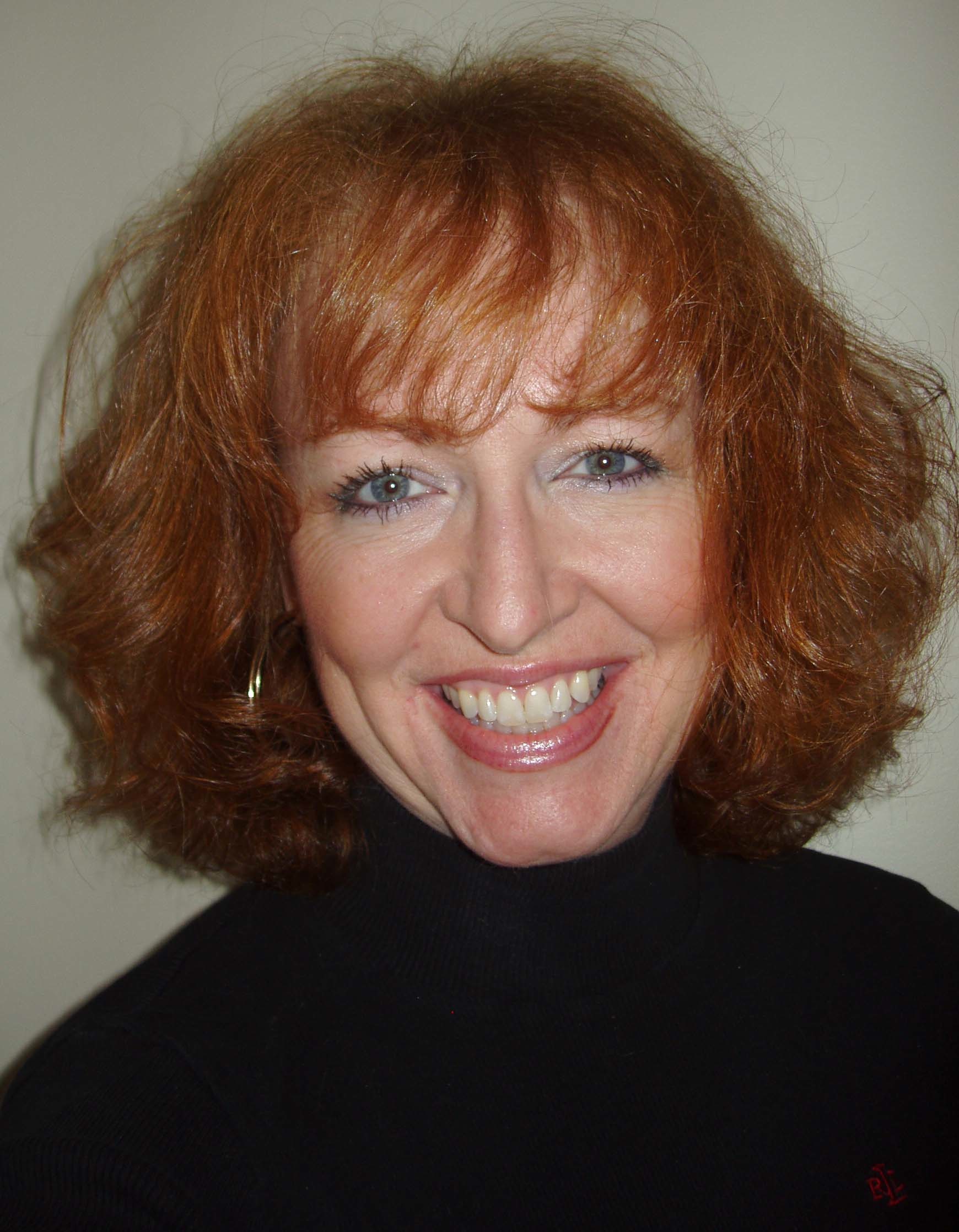How do Integral ARTISTS, Boomers, Gen X and Millennial Generations Impact City Values and Policy Development?
Marilyn Hamilton and Cherlynn Beck
Abstract
The generational wave is a supra-wave of human life patterns that embraces many of the waves normally considered in an Integral human development model. Embracing the waves of consciousness, values and capacity development in holons and social holons, the age cohort as defined by Strauss and Howe describes the archetypal characteristics of peers in generational cultures. According to their research age cohorts cycle through a saeculum (a series of four generations) before repeating the archetypal cycle. The generational cohorts create life conditions and mindsets that influence the emergence of levels and lines of development for succeeding generations, thus creating unique city cultures differentiated by generational demographics and value sets. This article explores the implications of integrating the mindset patterns of generational cycles into Integral Theory and uses the research in one city to demonstrate the impact generational considerations can have on policy development and lived experience.
Developmental Waves
Life flows through the city in many kinds of waves. Writers and researchers who have used an Integral Model for examining human life development have considered the waves of consciousness, values and worldview stages (Beck & Cowan, 1996, p. 99; Cook-Greuter, 1999, 2002; Hamilton, 2008; Kegan, 1994; Torbert, Livne-Tarandach, Herdman-Barker, Nicolaides, & McCallum, 2008; Wilber, 2000b, 2007). They have also considered the waves related to lines of development (Dawson-Tunik, 2005; Wilber, 2000a, 2007) or intelligences (Graves, 2003, 2005). In examining the city as human’s most complex system, Hamilton (2008, p. 63) has looked at all these framings in terms of holons (individuals) and social holons (collectives or groups) and proposed how the interaction of different stage developments enables different capacities for city change or resilience.
Ken Wilber’s Integral map (1995, 2007) makes visible the relationships of realities in an integrated way. The four quadrants reveal the place caring capacities present in the left hand quadrants of Psychological and Cultural realities (Hamilton, 2010d). The right hand quadrants reveal the place making capacities present in the Biological and Social/Structural realities (see Appendix A).
Within each of these quadrants emerges the eight (plus) levels of human development as differentiated by Clare Graves (Graves, 1974, 2003, 2005). These levels are based on a developmental, emergent model of bio-psycho-cultural-social human growth. They appear as if they are codes in people and cultures that unfold as life conditions trigger the potential for them to come on line. The codes have a fractal quality to them that cause them to pattern behaviour at all human scales from the individual to the organizational, geo-political and nation-state levels. These codes provide a way of framing and understanding the forces of human interactions and behavior (Beck, 2000, 2006; Beck & Cowan, 1996; Graves, 1974, 2003, 2005). Graves proposed, humans are complex adaptive systems and as such we are open ended and still evolving.
As these eight (plus) stages or waves unfold within individuals and communities, their capacity expands as people interact with internal and external conditions of existence. Table 1 identifies the trajectory of expansion that identifies the driving values that emerge as people transcend and include the values that have come from previous stages that they integrate as the size of the universe expands. The trajectory can be identified as: from Surviving, to Belonging, to Personal Power, to Authority, to Performance, to Caring and Sharing, to Flex and Flow, to Global Wellbeing. With each shift of the driving force, essentially the size of the universe for each individual and group also expands as noted in column 2 of Table 1.
A further proposition from Graves’ research and expanded by Spiral Dynamics (Beck & Cowan, 1996) showed that each of the levels alternated between an “I/Me/Mine” locus of control for the individual (Surviving/Beige, Power/Red, Performance/Orange, Flex & Flow/Yellow—identified in Spiral Dynamics as the Warm color codes ) and a “We/Us/Our” locus of control for the collective (Belonging/Purple, Authority/Blue, Caring & Sharing/Green, Global Wellbeing/Turquoise – identified in Spiral Dynamics as the Cool color codes).
Generational Waves
In contrast to the human stage developmentalists, Neil Howe and Bill Strauss (Howe & Strauss, 1992; Strauss & Howe, 1997) have framed growth and change in terms of generation patterns and cultural mood shifts. Strauss and Howe’s work sifts though 500 years of historical data, events and recordings in national (primarily American and British/European) contexts. As Integral thinking continues to emerge, mapping out the influence of generations on city health and wellbeing looks to be a practice that enables understanding, performance and alignment of across the city as a whole. Let us examine how we might operationalize such a practice by looking at the basic constructs of Generational Theory according to Howe and Strauss.
What is a Generation?
Howe and Strauss (Howe & Strauss, 1992; Strauss & Howe, 1997) talk about generations as: Cohorts marching through time, who encounter and respond to similar life conditions. They share with each other an AGE LOCATION in history. Different from other collective groupings of humans, generations are peer personalities. You and your peers, as a collective, form a unique adaptation to life that has within it an archetypal mindset that drives social behavioral patterns of a very large segment of the population: generations number in multiples of 10’s of millions of people. Generational peer personalities are very powerful agents of change and help describe the unfolding of human progress and evolution in potent ways.
Just like a letter does not represent a sentence, generations as social holons are not represented by one or two people. In fact, it is entirely possible that individuals may not identify nor exhibit the behaviors of the peer personality to which they belong. Nevertheless, they likely still carry the code of this generation by virtue of this dynamic: people are aware of what their peers are experiencing even if the individual is not experiencing the same thing. Individual personalities may identify more with one of the subgroups (Strauss and Howe pg 68);
Directive: those personalities that direct the social holon. These are individuals representing the whole to a significant degree. They set the overall tone.
Directed: those personalities that are directed by social holon. These individuals conform to the direction, or take the cues of the peer personality.
Repressed: those personalities that are repressed by the social holon. Their influence on the greater whole is insignificant because they withdraw, or in a few cases rebel.
Each person belongs to one primary generation because they have, and share with others, the same age location in history. It’s that location that unifies a generational cohort.
Relationship to Life Conditions
Generations form because they experience and respond to similar life conditions from similar stations in the human life cycle. The relationship between life conditions and human development/capacity and behavior has been much overlooked. Clare W. Graves (Graves, 1974) and later Don Beck (Beck & Cowan, 1996), through his popularization of Spiral Dynamics, have generated one of the most comprehensive models of this relationship. Ironically, it is the first helix of Clare Graves’ Double Helix model, Life Conditions, that often gets dropped from our understanding. To understand Generations we want to highlight the notion that humans have evolved because they have continually adapted to new, more complex life conditions. Stages of human development arise in relationship to the conditions that individuals and collective groups find themselves. Strauss and Howe’s work on Generations is as much a revelation in understanding life conditions, albeit partial but extremely relevant, as it is an outline of the personality characteristics of the generations themselves.
Clare Graves (Graves, 2003, 2005), through a longitudinal study developed an integral theory of human development encapsulated in this statement: by virtue of our success in thriving in a particular set of life conditions, we create new, more complex problems in their place, demanding the emergence of new complex adaptive intelligences and a reorganization to a “higher” form of civil institutions and structures. At the time of his research Clare Graves found that humans have emerged through increasing complexity at least six times in our past. Furthermore, it seems clear that humanity is now in the midst of a seventh and eighth emergence as current problems of existence press into our daily lives more and more every day. Normal adult human behavior is dynamic and changes throughout our lifespan, and has indeed evolved over the course of modern history. It is because humans encounter problems and wrestle with those problems, that humans have emerged through a spiral-like movement, over the long term, as the intelligent, globally mobile and interactive, technologically advanced species that exists today.
From this we could propose that having problems is not a problem. It’s what kind of problems are at play, and which intelligence, which social construct, is designed to support and solve those problems.
What is important here, is the connection, the relationship between mindsets and life conditions. New mindsets form in new conditions to handle the problems created by the prior mindset. Clare Graves’ model explicitly points to this relationship. Strauss and Howe implicitly point to this relationship. Clare Graves found complex adaptive intelligences at work underneath, the more surface level descriptions of Strauss and Howe’s historical pinning. We highlight this connection because it is what links these two frames into an even greater integral frame—one with a supra generational cycle that expands it’s explanatory, anticipatory, and directive power.
Cycles
Strauss and Howe explain that the human life span is expressed through natural aging and is broken down into four stages: childhood, coming of age or young adult, mid life, and elderhood. The conditions of life shape mindsets largely dependent on how old we are when we experience them. Thus, the same conditions or event will not be the same experience for someone in childhood as it is for another someone in mid life. These events serve as markers for a generation. They are “the events you remember most [as they] are suffused with the emotional complexion of your phase of life [and the corresponding social role] at the time.” (Strauss & Howe, 1997, p. 15)
Strauss and Howe (1997, p. 15)write:
Human history is made of lives, coursing from birth to death. All persons who are born must die, and all who die must first be born. The full sweep of human civilization is but the sum of this. Of all the cycles known to man, the human life cycle is the one we know the best. A generation, like an individual, is mortal. Its members know that in time we must all perish. The dynamics of generational aging enable a society to replenish its memory and evolve over time. Each time one generation replaces an older generation in each phase of life, the composite life cycle becomes something new altogether, fundamentally changing the entire society’s mood and behavior.
They go on to observe that, “History creates generations, and generations create history. This symbiosis between life and time explains why, if one is seasonal, the other must be [too].”(p.16) Generational structure and stability however, come because archetypal patterns appear to repeat while new generations entering the life cycle renew memory and add capability and intelligence.
It is usual to think of life span as a linear progression with a beginning and end marked by a sequential progress, where each segment is unique to itself, better or worse than the segment before or after. It certainly appears that human development has a sequential component to it. Clare Graves, in the company of a host of other developmentalists, found that one stage of human development is followed predictably by a second stage, then through an identifiable third stage and so on. Thus, from a linear perspective research shows that given suitable life conditions, our mindset grows more mature and gains more wisdom as we age and life experience calls it forth.
Linear time is so prevalent in the western mind it takes a conscious deviation to think about it differently. Thinking about cultural environments in terms of generations calls us out of a linear understanding into a cyclical or seasonal time orientation. Cycle time is repeating, regenerating, natural. Cyclical time can be broken down into segments where each segment is the same for each cycle. Moreover, at least one of the segments in a natural cycle includes a segment of some kind of destruction or death. Strauss and Howe (1997, p. 11) remind us “Cyclical time calls us into the eternal, it connects us back to ourselves and relieves much of the fear of the future.” They go on to point out the value of cycle time: “When we deem our social destiny entirely self-directed and our personal lives self-made, we lose any sense of participating in a collective myth larger than ourselves.” (We note that, generational theory, at present, doesn’t include non-linear time, but our suspicion is that there is much more to learn here that will prove valuable dealing with the current milieu.)
From an Integral perspective all these forms of time are present and relevant, impacting human lives. Generational theory helps reveal the cyclic nature of these logics of time and once integrated into a broad framing of reality may enable us to enter into a more fulfilling and more synchronized existence with our environments. Strauss and Howe found that throughout American history (backcasting about 500 years), cultural mood shifted from a High, to an Awakening, to an Unraveling and through to a Crisis and then repeated again: High, Awakening, Unravelling and Crisis.
From a metaphorical perspective, it is like thinking of cultural mood as a seasonal weather pattern. One can think of cultural mood shifts as seasonal mindsets which change as aging generations shift how they think about themselves and what they think about their society, driving how generational peer groups behave. Each season has a distinctive feel and character to it. Mindsets are like weather—forces of nature in the general milieu that attract, repel us, challenge us and give us pleasure as we interact with our environments. They dictate the kind of activities and lifestyle that we enact to survive and, over time, have increasingly learned how to thrive in. A person can imagine how behavior changes the activities one might be compelled towards and which they leave behind once Spring becomes Summer, Summer becomes Fall, Fall becomes Winter and Winter becomes Spring. Such are the cultural mood seasons when the High becomes an Awakening, the Awakening becomes an Unravelling, the Unravelling becomes a Crisis and a Crisis turns back into a High.
The chart in Appendix B shows a few specific cultural mood domains and how they change from a 1st turning, High, to a 2nd turning Awakening, to a 3rd turning Unravelling, to a 4th turning Crisis. A few minutes with this chart shows the kinds of change that have cycled around Americans—and to a measurable degree, the Western world—over the last four to five hundred centuries. (One can see that these patterns are beginning to develop across the planet as the western mindset replicates from culture to culture.)
Turnings
Strauss and Howe proposed that these turnings last about 20-22 years. Here is how Strauss and Howe (1997, p. 3) describe each turning :
- The First Turning is High: an upbeat era of strengthening institutions and weakening individualism, when a new civic order implants and the old values regime decays.
- The Second Turing is an Awakening: a passionate era of spiritual upheaval, when the civic order comes under attack from a new values regime.
- The Third Turning is an Unravelling: a downcast era of strengthening individualism and weakening institutions, when the old civic order decays and the new values regime implants.
- The Fourth Turning is a Crisis: a decisive era of secular upheaval when the values regime propels the replacement of the old civic order with a new one.
What is important to understand is the cyclical nature of our life conditions. Most of us are susceptible to the thinking that sees the next 5 or 10 years as a linear progression of the last 20 years. This is an error in thinking, because conditions also cycle. The next 10 years will be distinctly different from the last 20 years, just like Winter is distinctly different from the Fall, opposite of the Summer, and a necessary phase before a Spring. Moreover, Winter is very similar to previous Winters.
Mindsets drive behavior. When we start to consider the generational seasons that impact our lives, it is possible to frame that a major shift happens as Turnings change. Without generational lenses we can often sense the change more than explain it—just like those early days in winter, when the leaves have not dropped from the trees, the daylight is shorter and there is an unmistakable chill in the air. In America—and probably for much of the western world—in the 2010’s, we are now experiencing the cultural mood of a Fourth Turning.
Saeculum
Across the four Turnings, the mindsets shift four times, creating approximately an 80 year Saeculum cycle. The term Saeculum helps bring together the rhythms of generations, mindsets and cyclical time. A Saeculum is an historical recording of one cycle of a society. Length of time is roughly equal to the potential lifetime of a person, or the equivalent of the complete renewal of a human population. The term was first used by the Etruscans to record the history of cities. In generational theory the term is resurrected to define national history, and in the context of Integral Cities, we are going to extend it into looking at the cyclical renewal of the living system that is the city.
The life span of a modern human is about 80 years old. So a Saeculum is about 80 years long as well. Its beginning and end are marked by the birth and death cycles of it citizens and it is described in terms of the cultural seasonal turnings and the events that comprise them. Strauss and Howe (1997, pp. 123-138) articulate seven Saecula in America history, naming the current Saeculum, the Millennial Saeculum.
Generations, in general, are born with one of the cultural seasons, they come of age in the next cultural season, live through mid life in the third season and complete their lives in yet a fourth cultural season. Strauss and Howe map out a pattern of synchronization where generations born in First Turning/High develop a collective mindset of an Idealist; generations born in a 2nd Turning/ Awakening develop a Reactive mindset; those born in 3rd Turning/Unravelling a Civic mindset; and those born in the 4th Turning/Crisis form an Adaptive mindset.
Generational Archetypes
Each generation comes of age in having experienced a different season in childhood and also under the influence from the other generations in their Saeculum constellation. Thus, being 16 is not the same 16, as what being 16 was 20 years earlier. So your personal experience will not be a good indicator of what being 16 will be like for your children. Strauss and Howe suggest that a more informative indicator is to look 80 years back, where being 16 is a more similar experience. So the culture mood changes, the life span changes, our experiences change and our mindsets change. These then are archetypes, repeating across Saeculum after Saeculum.
Layering in the terminology of archetype, mindset and life course, let us now take a look at each generational type as Strauss and Howe’s (1997, p. 84) sketches suggest they might be.
Prophets have Idealist mindsets. They are spiritually driven, moralistic, focused on self, and willing to fight to the death for what they believe in.
Nomads have Reactive mindsets. They are ratty, tough, unwanted, diverse, adventurous and extremely cynical.
Heros have Civic mindsets. They are conventional, über-powerful, homogeneous and devoted to serving the state, having a deep trust in authority and being the perfect soldiers for a major war.
Artists have Adaptive mindsets. They are subtle, nice (sometimes too nice), indecisive, emotional and inoffensive, often having to deal with feelings of repression and inner conflict.
As each generation ages, it shapes and is shaped by the cultural turnings. Each movement through a new stage forms a new mindset. (Strauss & Howe, 1997, p. 84)
A Prophet Generation grows up as increasingly indulged Post Crisis-High children, comes of age as the narcissistic young crusaders of an Awakening, cultivates principles as moralistic mid-lifers, and emerges as wise elders guiding the next Crisis.
A Nomad Generation grows up as under protected children during an Awakening, comes of age as the alienated young adults of a post-Awakening world, mellows into pragmatic midlife leaders during a Crisis and ages into tough post-Crisis elders.
A Hero Generation grows up as increasingly protected post-Awakening children, comes of age as the heroic young team workers of a Crisis, demonstrates hubris as energetic mid-lifers, and emerges as powerful elders attacked by the next Awakening.
An Artist generation grows up as overprotected children during a Crisis, comes of age as the sensitive young adults of a post-Crisis world, breaks free as indecisive midlife leaders during an Awakening, and ages into empathic post-Awakening elders.
It is the constellation of generations moving through time at different stages of life responding within a cultural mood using their current mindset, and in their wake creates the next Turning of cultural mood, historical events and mindset changes. “They age in place … overlapping in time, corrective in purpose, complementary in effect. As generations age, they together form new archetypal constellations that alter every aspect of society, from government and the economy to culture and family life. Over the course of a cycle, these constellations can produce sharply different social results.” (Strauss & Howe, 1997, p. 99)
Reflect how unalike the following two societies will be: One is run by expansive old Heros and uncertain mid-life Artists whose combined public works are torched by fiery young Prophets and whose freedoms are inconvenienced by hurried Nomad children.
The other is led by judgmental old Prophets and pragmatic mid-life Nomads, whose combined public works are assisted by team-playing young Heros and whose duties are unimpeded by quiescent child Artists.
The former is an Awakening constellation like that of [four] decades ago, during the Consciousness Revolution, the latter is a Crisis constellation like that of World War II and the Crisis era we’ve just entered. (Strauss & Howe, 1997, pp. 99, emphasis added)
The Current generation constellation includes Silent Artists (late elders), Boomers as our Prophets,(elders), GenX Nomads (mid life), Millennials Heros (Young adult) and Homeland Artists who are just being born now into their (Childhood) years. “In cyclical time, a society always evolves. Usually, through…a spiral of progress, some times a spiral of decline. Always, people strive to mend the errors of the past, to correct the excesses of the present, to seek a future that provides, whatever feels most in need. Thus a civilization can endure and thrive.” (Strauss & Howe, 1997, p. 105) According to Strauss and Howe’s timetable, we have just turned from the Fall of our cultural generational season to the Winter of history. With it a new life cycle stage for each generation is emerging. The impulse for a mindset shift is pulsing within each generation. But what is most comforting from this theory is that we can see a new role, perfectly formed for each generation to be able to meet and survive in the new conditions. Thus far, we humans have been the unconscious participants of this natural change process. What if this Fourth Turning demands a conscious engagement? What could we be inspired toward?
Integrating Generations and Integral Frameworks in Society
The third section of this article considers the evidence for generational differences at the scale of the city. The theory of generational waves provides a context that is both demographic and dynamic for observing the life conditions that Graves proposed formed one of the strands in the double helix of human’s complex adaptive system. Elsewhere Hamilton (Hamilton, 2008) has described, as she has looked at the Integral City, how the theories of resilience and organizational lifecycles emerge through similar four stage cycles that contribute to our understanding of ecological resilience, biological adaptiveness and social stages of human life.
Generational theory gives us lenses to consider the contributions of generations within a Saeculum cycle to city behaviours, mindsets, cultures and systems, in other words the bio-psycho-cultural-social realities embedded in the four quadrants of the Integral City model.
North American Generational Values
The first step we took prior to examining the city research (described below) was to map the values of each of today’s current generations using the descriptors supplied by Strauss and Howe. In this map (shown in Appendix C) we proposed the values map for each North American generation (indicating the top three values) in 2010 as shown in Table 2.
Millennials (Approximate Age Range 5-24): Strong Caring (Green), Personal Expression (Red) and Family/Belonging (Purple) values
Gen X (Approximate Age Range 25-44): Strong Personal Expression (Red), Results/Performance (Orange) and Flex Flow Wisdom (Yellow) values
Boomers (Approximate Age Range 45-64): Strong Results/Performance (Orange), Order (Blue), Personal Expression (Red) values
Silent-Artist (Approximate Age Range 65-84): Strong Order (Blue), Family/Belonging (Purple), Results/Performance (Orange) values
Table 2: North American Generational Values (expressed in top 3 strengths)
Several patterns we noticed when we completed this analysis was that the Millennials and the Silent-Artist generations tended towards the cool “We/Us/Our” values of Family/Belonging, Order and Caring. On the other hand GenX and the Boomers tended towards the warm “I/Me/Mine” values of Personal Expression and Results/Performance. This may make the Millennials and the Silent/Artist generations more attractive to each other because of these shared cool values systems. Likewise the Boomers and GenX may be more attracted to each other because of their warm values systems. Thus we could observe that values develop differently as generations create life conditions for their Preceding, Peer, Extant and Succeeding Generations. A single example helps illustrate this. We refer to the descriptors in Appendix B for the Boomer Generation:
In the First Turning (1946-1964) they are indulged (by their Silent/Artist parents who just lived through WWII).
In the Second Turning (1964-1984) they are narcissistic as they come of age as young adults seeking spiritual enlightenment in a world they feel owes them a living.
In the Third Turning (1984-2005?) they are moralistic as they intend to defend their values in mid-life despite culture wars and technological rollercoasters .
In the Fourth Turning (2005?-202?) they are coming into their wisdom as they assume elderhood and are faced with financial crisis.
Thus we can see (Appendix B and C) that each generation influences the one(s) they are procreating (as parents), co-creating (as peers) and recreating (as grandparents/elders). And we can see that the generational waves generate mindsets that move through the city in a cycle that influences individual opportunities (for education, careers, investments, etc.) and collective policies (embedded in public-private-social profit relationships, laws and policies).
Integrating Generations and Integral Frameworks in a City
A recent research project studying the values of Abbotsford, BC, Canada, a small multi-cultural city provided us with age related data that allowed us to examine what we could learn relevant to understanding how to apply generational findings to policy development (Hamilton, 2010a, 2010b, 2010c, 2010d).
Individual Values
In identifying the age related data of the city from two data sets (one a statistically valid random population sample and the other a purposive culturally representative sample) Hamilton found that the individual generational values in Abbotsford varied from the North American values map in Appendix B.
Appendix D shows that individual values across all ages in Abbotsford tended to cluster in the cool values systems, largely because of the strong influence of immigrant populations who share these values (Hamilton, 2010a, 2010b, 2010c, 2010d). In 2010, individual values in Abbotsford tended to show strong resonance with the “We” based values of Family/Belonging, Order, and Caring. Thus we can consider this to be the values system norms that dominate the mindsets, behaviours and the culture of Abbotsford across all age groups and distinguish it both from the North American values map and the earlier Abbotsford 2003 values map (when the value of Results/Performance registered as a strong “improvement” value, while in 2010 it disappeared from the map for reasons discussed in Hamilton (2010d).
What Works Well and Could Work Better?
These individual values seem to be born out across all age data when we look at what Abbotsford residents consider works well in the city. Respondents indicated that “what works well” (Appendix E) are the values systems of Family/Belonging (Purple), Order (Blue) and Caring (Green). When asked “what would work better?” in the city (Appendix F) the respondents indicated essentially that they wanted more of the same Family/Belonging (Purple), Order (Blue) and Caring (Green). Thus, the question sets related to “what works well?” and “what could work better?” basically affirm the values that give Abbotsford 2010 residents the greatest comfort.
What Does Not Work Well?
However, when given the opportunity to identify what is not working well in the city we are able to see the kind of age related indicators that differentiate age cohorts. The data in Table 3 (derived from Appendix G) revealed age differentiated perspectives on what is not working for each generation. (Note that these age ranges are somewhat offset from the Strauss and Howe ranges, but with similar medians.)
Millennials (Age Range 13-28): Personal Expression (Red), Order (Blue) and Flex Flow Wisdom (Yellow)
Gen X (Approximate Age Range 35-55): Personal Expression (Red)
Boomers (Approximate Age Range 55-74): Order (Blue), Caring (Green)
Silent-Artist (Approximate Age Range 65-84): Order (Blue), Caring (Green), Flex Flow Wisdom (Yellow).
Table 3: Abbotsford Generational Values of “What’s Not Working”
Generational Differences Create Tensions, Opportunities, Shift-Points
The Abbotsford research identified differences in values that could be correlated with age cohorts. In addition it also identified differences in values that could be correlated to language groups/ethnicities and geographic locations in the city, but the scope of this article does not allow exploration of these other contexts.
Applying the Findings about generational differences to policy development related to the creation of welcoming and inclusive communities, Hamilton recommended approaches that varied by generational cohort. Because the study was particularly focused on the wellbeing of young people (Millennials and GenX), recommendations focused on creating conditions that would enable healthy personal expression for these generations. This in turn was backed up by recommendations to educate the Boomer and Silent-Artist generations to support this unmet need. In fact, the way that these recommendations were implemented, the policy makers within the two older generational cohorts were given support to enable the Millennials and GenX to become leaders. Thus the Boomer parents and Artist grandparents had to learn new skills and reframe expectations so that Millennials and GenX could express themselves as leaders. Some examples of what the Millennials did included designing and delivering a conference for youth as a “Day of Action” where they became volunteer activists, presenting proposals for funding projects, and committing to a long term entrepreneurial initiative focused on international food experiences on a university campus.
At the time of this writing the outcome of taking this generational approach not only addressed the dissatisfactions (what’s not working?) of the Millennials and GenX’s but in doing so had the ripple effect of addressing what the Boomers and Artists wanted – more order and caring and wisdom. Overall, within the Abbotsford community this gives a more effective alignment of the full spiral of capacities. It meshes what was working well from the Cool “We/Us/Our” value systems of Purple (Family/Belonging) Order (Blue) and Caring (Green) with the Warm “I/Me/Mine” value systems of Personal Expression (Red), and FlexFlow Wisdom (Yellow). Furthermore, with the entrepreneurial aspect it also reintroduces the values system of Results/Performance (Orange). Thus, with the turnarounds from what was not working for the younger generations being integrated with already existing strengths of the community, greater capacity emerges for the whole city.
Conclusion
This article has described how the phenomenon of generational cycles can be understood within the Integral model as a supra-wave that transcends the “all quadrants, all levels, all lines” waves of Integralism. Generational patterns help explain the connections that emerge amongst mindsets that progress through life in the stage waves marked by childhood, early adulthood, maturity and elderhood. Generational patterns help to reveal how each generation creates life conditions that impact the parents and grandparents and the peers and succeeding generations who live in the city. These patterns illustrate how generations co-create key aspects of the life conditions strand of the double helix that Graves proposed was intertwined with the developmental sequence of human development.
As we become aware of generational impacts we can detect the patterns in large overviews of global population clusters (like the analysis of the North American generational values systems). We can also peer more closely at an individual city (like Abbotsford) and recognize how policy decisions can impact the relationship of generations, one to another, and to the development of leaders in younger generations.
Using these generational cycles to better understand the city, we can apply the Principles for Living Systems that Hamilton proposes in Integral City:
- Honor the dance of life cycles in the city (map them and track them).
- Integrate the natural cycles of change within the city (adjust and mesh policy development to adapt wisely).
- Learn how to zoom in and out at different scales to dance with the fractal patterns of the city (see the city in context of its four generation-Saeculum, cultural makeup, surrounding region, global trading partners).
As we honor the dance of generational life cycles in the city it will contribute to living the Master Principle of the Integral City.
- Take Care of Yourself
- Take Care of Each Other
- Take Care of This Place
References
Beck, D. (2000). Stages of Social Development: The Cultural Dynamics that Spark Violence, Spread Prosperity and Shape Globalization. Paper presented at the State of the World Forum.
Beck, D. (2006). Spiral Dynamics Integral, Level 1 Course Manual. Denton, TX: Spiral Dynamics Group.
Beck, D., & Cowan, C. (1996). Spiral Dynamics: Mastering Values, Leadership and Change. Malden, MA: Blackwell Publishers.
Cook-Greuter, S. (1999). Postautonomous ego development: its nature and measurement
Unpublished Doctoral dissertation, UMI Dissertation Information Services UMI #9933122, Harvard Graduate School of Education, Cambridge, MA.
Cook-Greuter, S. (2002). The development of action logics in detail. Retrieved from www.cook-greuter.com
Dawson-Tunik, T. L., Commons, M. L., Wilson, M., & Fischer, K. W. (2005). The shape of development. The European Journal of Developmental Psychology, 2(2), 163-196.
Graves, C. (1974). Human Nature Prepares for a Momentous Leap The Futurist.
Graves, C. (2003). Levels of Human Existence: Transcription of a Seminar at Washington School of Psychiatry, Oct. 16, 1971. Santa Barbara: Eclet Publishing.
Graves, C. (2005). The Never Ending Quest: A Treatise on an Emergent Cyclical Conception of Adult Behavioral Systems and Their Development. Santa Barbara, CA: ECLET Publishing.
Hamilton, M. (2008). Integral City: Evolutionary Intelligences for the Human Hive. Gabriola Island BC: New Society Publishers.
Hamilton, M. (2010a). Abbotsford Integral Vital Signs Monitor. Abbotsford: Integral City Meshworks Inc.
Hamilton, M. (2010b). Appendices for Report: Mapping the Values of Abbotsford and Developing a Prototype for an Integral Vital Signs Monitor of City Wellbeing Abbotsford, BC, Canada: Integral City Meshworks Inc.
Hamilton, M. (2010c). Executive Summary: Mapping the Values of Abbotsford and Developing a Prototype for an Integral Vital Signs Monitor of City Wellbeing Abbotsford, BC, Canada: Integral City Meshworks Inc.
Hamilton, M. (2010d). Mapping the Values of Abbotsford and Developing a Prototype for an Integral Vital Signs Monitor of City Wellbeing Abbotsford, BC, Canada: Integral City Meshworks Inc.
Howe, N., & Strauss, W. (1992). Generations: The History of America’s Future, 1584 to 2069 New York: Harper Perennial.
Kegan, R. (1994). In Over Our Heads: The Mental Demands of Modern Life. Cambridge, MA: Harvard University Press.
Strauss, W., & Howe, N. (1997). The Fourth Turning: An American Prophecy, What the Cycles of History Tell Us About America’s Next Rendezvous with Destiny. New York: Broadway Books.
Torbert, W. R., Livne-Tarandach, R., Herdman-Barker, E., Nicolaides, A., & McCallum, D. (2008). Developmental Action Inquiry:A Distinct Integral Theory That Actually Integrates Developmental Theory, Practice, and Research. Paper presented at the Conference – Integral Theory In Action: Serving Self, Community and Kosmos.
Wilber, K. (1995). Sex, Ecology and Spirituality: the spirit of evolution. Boston: Shambhala Publications Inc.
Wilber, K. (2000a). Integral Psychology. Boston: Shambhala Publications Inc.
Wilber, K. (2000b). A Theory of Everything. Boston: Shambhala Publications Inc.
Wilber, K. (2007). The Integral Vision. Boston: Shambhala Publications Inc.
Appendices
Appendix A: Quadrant Map: Place Caring, Place Making

Appendix B: Generational Cycles, Turnings and Saeculum
© 2011 Cherlynn Beck, with Permission
Appendix C: Generations Individual Values based on Strauss & Howe, Estimated 2010
Appendix D: Values Self Descriptions by Age Cohort
Appendix E: What Works Well by Age Cohort
Appendix F: What Does NOT Work Well by Age Cohort
Appendix G : What Would Work Better by Age Cohort
About the Authors
Marilyn Hamilton, PhD, CGA, CSP: is founder of Integral City Meshworks Inc. and TDG Global Learning Connections. She is a charter member of Integral Institute and Centre for Human Emergence: Canada. Author of Integral City: Evolutionary Intelligences for the Human Hive (2008, New Society Publishers) Marilyn teaches the integral framework for designing change in the city that is ecologically informed and operationally integrated.
. and she is a Prophet.
Cherlynn Beck is master practitioner and trainer of Spiral Dynamics integral; an emissary for Strauss and Howe’s seminal work on Generations and Cyclical Change; a certified executive coach; a subject matter expert to OD consultants; and partner in American City Girls – an experimental project integrating social networking technology within a regional community.
. and she is Nomad

